Reflective Analysis: Exploring Influencing and Decision-Making Models
VerifiedAdded on 2023/06/10
|20
|5017
|95
Essay
AI Summary
This essay provides a reflective analysis of decision-making styles, models, concepts, and theories, emphasizing their importance for managers in various circumstances. It explores different decision-making tools, including the rational model, bounded rational model, nominal group think, Delphi technique, stepladder technique, and deliberative, intuitive, and considerative modes. The essay includes a self-reflection on personal decision-making skills, referencing the Myers-Briggs Type Indicator (MBTI) to understand individual capabilities. It compares personal decision-making styles with established models and discusses the levels of rationality and intuition utilized in the reflective section, concluding with key insights and implications for effective decision-making.
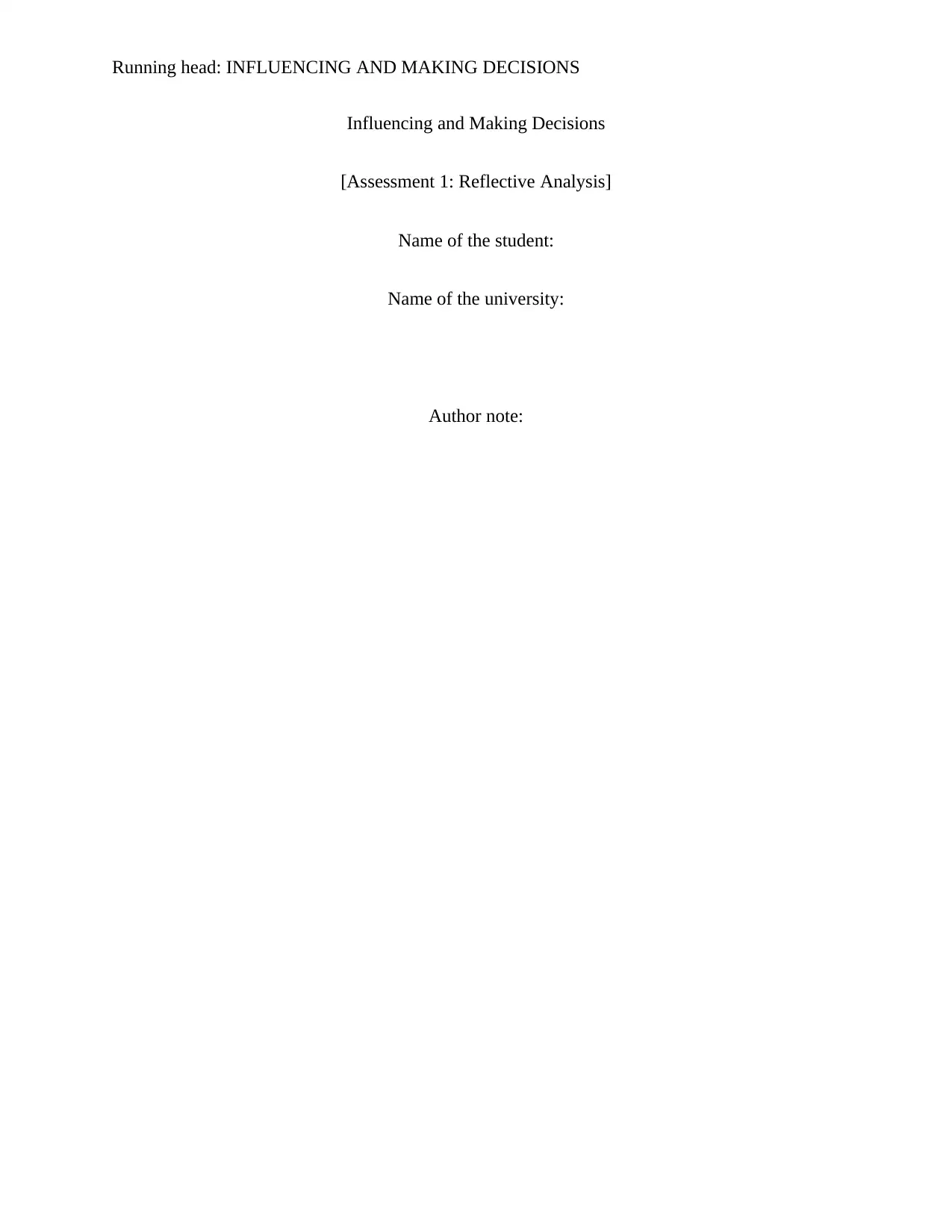
Running head: INFLUENCING AND MAKING DECISIONS
Influencing and Making Decisions
[Assessment 1: Reflective Analysis]
Name of the student:
Name of the university:
Author note:
Influencing and Making Decisions
[Assessment 1: Reflective Analysis]
Name of the student:
Name of the university:
Author note:
Paraphrase This Document
Need a fresh take? Get an instant paraphrase of this document with our AI Paraphraser
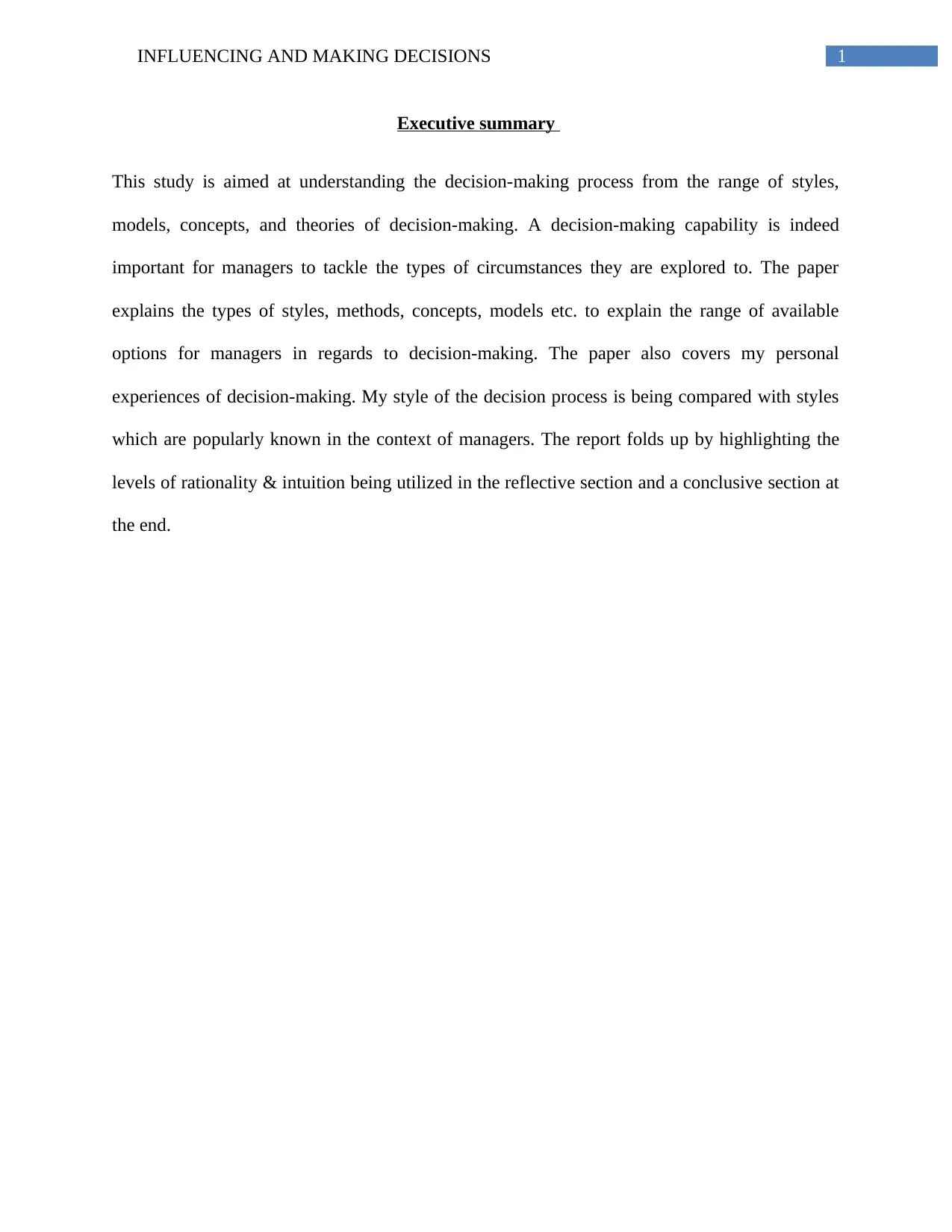
1INFLUENCING AND MAKING DECISIONS
Executive summary
This study is aimed at understanding the decision-making process from the range of styles,
models, concepts, and theories of decision-making. A decision-making capability is indeed
important for managers to tackle the types of circumstances they are explored to. The paper
explains the types of styles, methods, concepts, models etc. to explain the range of available
options for managers in regards to decision-making. The paper also covers my personal
experiences of decision-making. My style of the decision process is being compared with styles
which are popularly known in the context of managers. The report folds up by highlighting the
levels of rationality & intuition being utilized in the reflective section and a conclusive section at
the end.
Executive summary
This study is aimed at understanding the decision-making process from the range of styles,
models, concepts, and theories of decision-making. A decision-making capability is indeed
important for managers to tackle the types of circumstances they are explored to. The paper
explains the types of styles, methods, concepts, models etc. to explain the range of available
options for managers in regards to decision-making. The paper also covers my personal
experiences of decision-making. My style of the decision process is being compared with styles
which are popularly known in the context of managers. The report folds up by highlighting the
levels of rationality & intuition being utilized in the reflective section and a conclusive section at
the end.
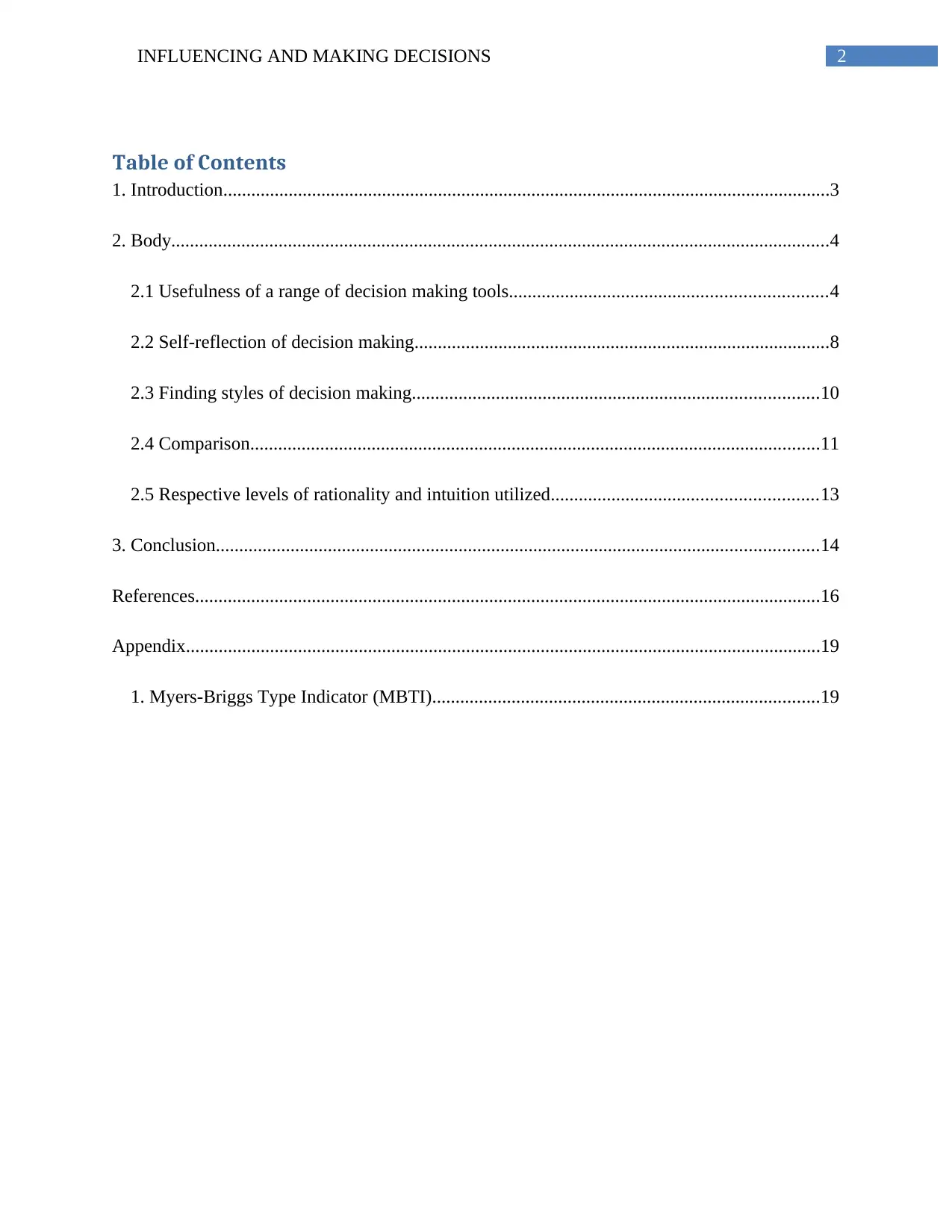
2INFLUENCING AND MAKING DECISIONS
Table of Contents
1. Introduction..................................................................................................................................3
2. Body.............................................................................................................................................4
2.1 Usefulness of a range of decision making tools....................................................................4
2.2 Self-reflection of decision making.........................................................................................8
2.3 Finding styles of decision making.......................................................................................10
2.4 Comparison..........................................................................................................................11
2.5 Respective levels of rationality and intuition utilized.........................................................13
3. Conclusion.................................................................................................................................14
References......................................................................................................................................16
Appendix........................................................................................................................................19
1. Myers-Briggs Type Indicator (MBTI)...................................................................................19
Table of Contents
1. Introduction..................................................................................................................................3
2. Body.............................................................................................................................................4
2.1 Usefulness of a range of decision making tools....................................................................4
2.2 Self-reflection of decision making.........................................................................................8
2.3 Finding styles of decision making.......................................................................................10
2.4 Comparison..........................................................................................................................11
2.5 Respective levels of rationality and intuition utilized.........................................................13
3. Conclusion.................................................................................................................................14
References......................................................................................................................................16
Appendix........................................................................................................................................19
1. Myers-Briggs Type Indicator (MBTI)...................................................................................19
⊘ This is a preview!⊘
Do you want full access?
Subscribe today to unlock all pages.

Trusted by 1+ million students worldwide
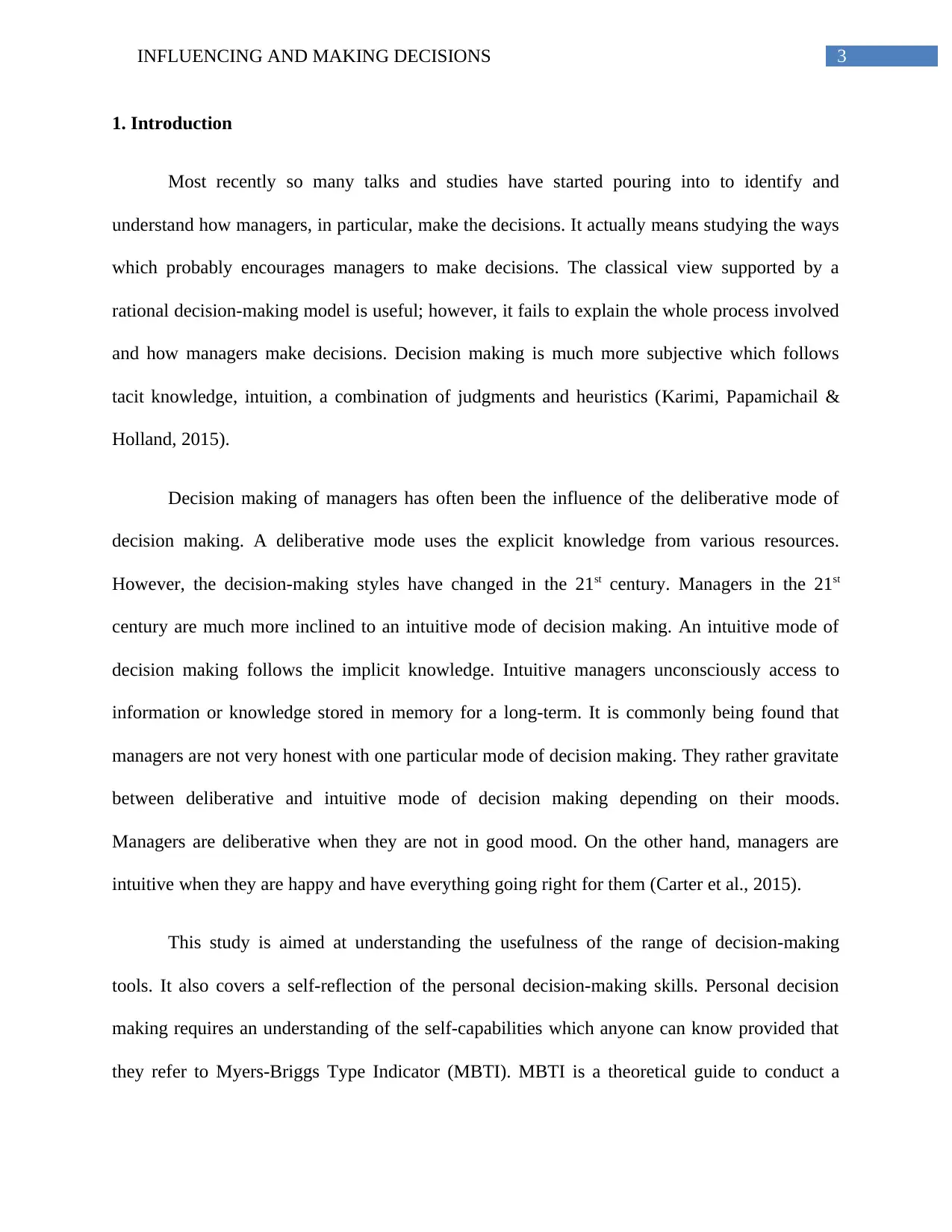
3INFLUENCING AND MAKING DECISIONS
1. Introduction
Most recently so many talks and studies have started pouring into to identify and
understand how managers, in particular, make the decisions. It actually means studying the ways
which probably encourages managers to make decisions. The classical view supported by a
rational decision-making model is useful; however, it fails to explain the whole process involved
and how managers make decisions. Decision making is much more subjective which follows
tacit knowledge, intuition, a combination of judgments and heuristics (Karimi, Papamichail &
Holland, 2015).
Decision making of managers has often been the influence of the deliberative mode of
decision making. A deliberative mode uses the explicit knowledge from various resources.
However, the decision-making styles have changed in the 21st century. Managers in the 21st
century are much more inclined to an intuitive mode of decision making. An intuitive mode of
decision making follows the implicit knowledge. Intuitive managers unconsciously access to
information or knowledge stored in memory for a long-term. It is commonly being found that
managers are not very honest with one particular mode of decision making. They rather gravitate
between deliberative and intuitive mode of decision making depending on their moods.
Managers are deliberative when they are not in good mood. On the other hand, managers are
intuitive when they are happy and have everything going right for them (Carter et al., 2015).
This study is aimed at understanding the usefulness of the range of decision-making
tools. It also covers a self-reflection of the personal decision-making skills. Personal decision
making requires an understanding of the self-capabilities which anyone can know provided that
they refer to Myers-Briggs Type Indicator (MBTI). MBTI is a theoretical guide to conduct a
1. Introduction
Most recently so many talks and studies have started pouring into to identify and
understand how managers, in particular, make the decisions. It actually means studying the ways
which probably encourages managers to make decisions. The classical view supported by a
rational decision-making model is useful; however, it fails to explain the whole process involved
and how managers make decisions. Decision making is much more subjective which follows
tacit knowledge, intuition, a combination of judgments and heuristics (Karimi, Papamichail &
Holland, 2015).
Decision making of managers has often been the influence of the deliberative mode of
decision making. A deliberative mode uses the explicit knowledge from various resources.
However, the decision-making styles have changed in the 21st century. Managers in the 21st
century are much more inclined to an intuitive mode of decision making. An intuitive mode of
decision making follows the implicit knowledge. Intuitive managers unconsciously access to
information or knowledge stored in memory for a long-term. It is commonly being found that
managers are not very honest with one particular mode of decision making. They rather gravitate
between deliberative and intuitive mode of decision making depending on their moods.
Managers are deliberative when they are not in good mood. On the other hand, managers are
intuitive when they are happy and have everything going right for them (Carter et al., 2015).
This study is aimed at understanding the usefulness of the range of decision-making
tools. It also covers a self-reflection of the personal decision-making skills. Personal decision
making requires an understanding of the self-capabilities which anyone can know provided that
they refer to Myers-Briggs Type Indicator (MBTI). MBTI is a theoretical guide to conduct a
Paraphrase This Document
Need a fresh take? Get an instant paraphrase of this document with our AI Paraphraser
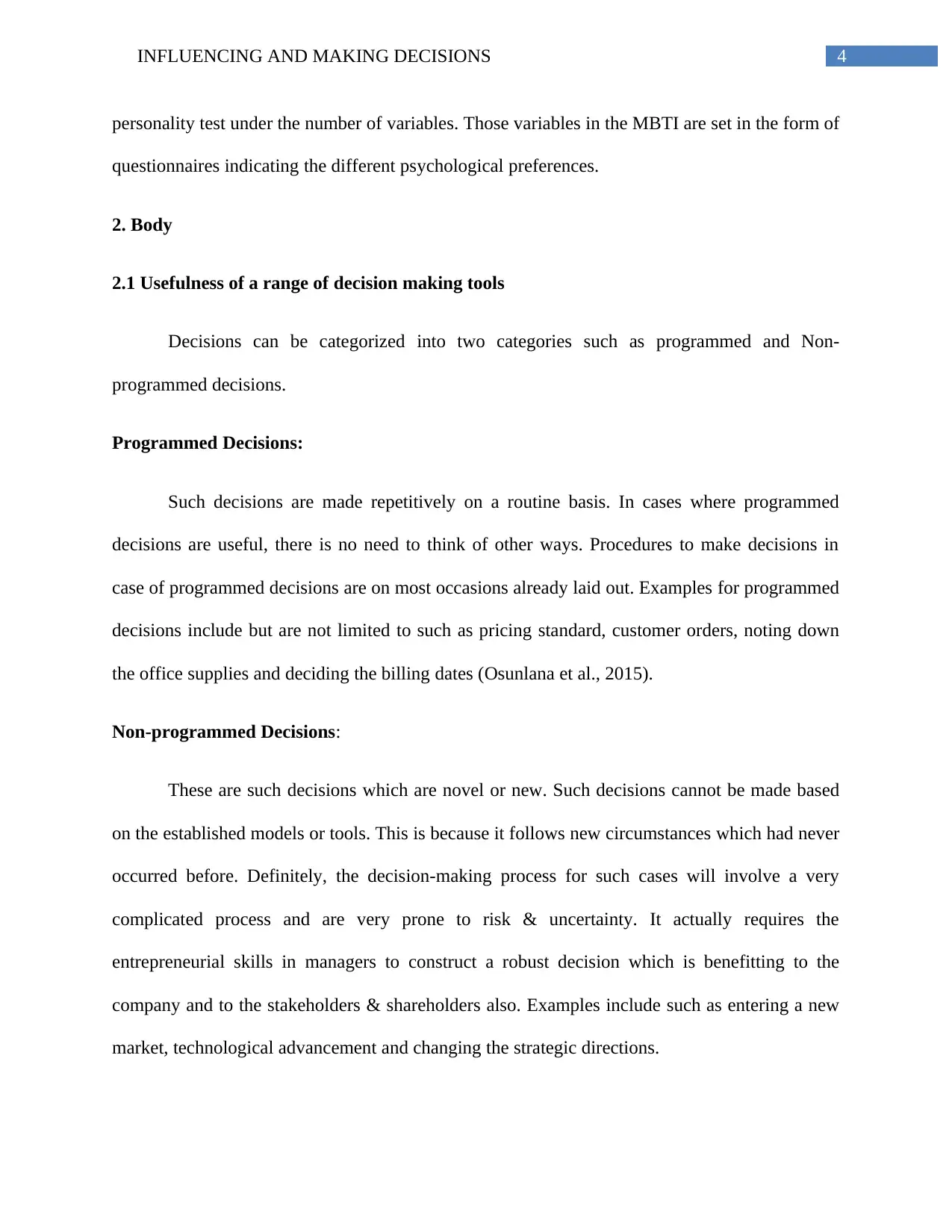
4INFLUENCING AND MAKING DECISIONS
personality test under the number of variables. Those variables in the MBTI are set in the form of
questionnaires indicating the different psychological preferences.
2. Body
2.1 Usefulness of a range of decision making tools
Decisions can be categorized into two categories such as programmed and Non-
programmed decisions.
Programmed Decisions:
Such decisions are made repetitively on a routine basis. In cases where programmed
decisions are useful, there is no need to think of other ways. Procedures to make decisions in
case of programmed decisions are on most occasions already laid out. Examples for programmed
decisions include but are not limited to such as pricing standard, customer orders, noting down
the office supplies and deciding the billing dates (Osunlana et al., 2015).
Non-programmed Decisions:
These are such decisions which are novel or new. Such decisions cannot be made based
on the established models or tools. This is because it follows new circumstances which had never
occurred before. Definitely, the decision-making process for such cases will involve a very
complicated process and are very prone to risk & uncertainty. It actually requires the
entrepreneurial skills in managers to construct a robust decision which is benefitting to the
company and to the stakeholders & shareholders also. Examples include such as entering a new
market, technological advancement and changing the strategic directions.
personality test under the number of variables. Those variables in the MBTI are set in the form of
questionnaires indicating the different psychological preferences.
2. Body
2.1 Usefulness of a range of decision making tools
Decisions can be categorized into two categories such as programmed and Non-
programmed decisions.
Programmed Decisions:
Such decisions are made repetitively on a routine basis. In cases where programmed
decisions are useful, there is no need to think of other ways. Procedures to make decisions in
case of programmed decisions are on most occasions already laid out. Examples for programmed
decisions include but are not limited to such as pricing standard, customer orders, noting down
the office supplies and deciding the billing dates (Osunlana et al., 2015).
Non-programmed Decisions:
These are such decisions which are novel or new. Such decisions cannot be made based
on the established models or tools. This is because it follows new circumstances which had never
occurred before. Definitely, the decision-making process for such cases will involve a very
complicated process and are very prone to risk & uncertainty. It actually requires the
entrepreneurial skills in managers to construct a robust decision which is benefitting to the
company and to the stakeholders & shareholders also. Examples include such as entering a new
market, technological advancement and changing the strategic directions.
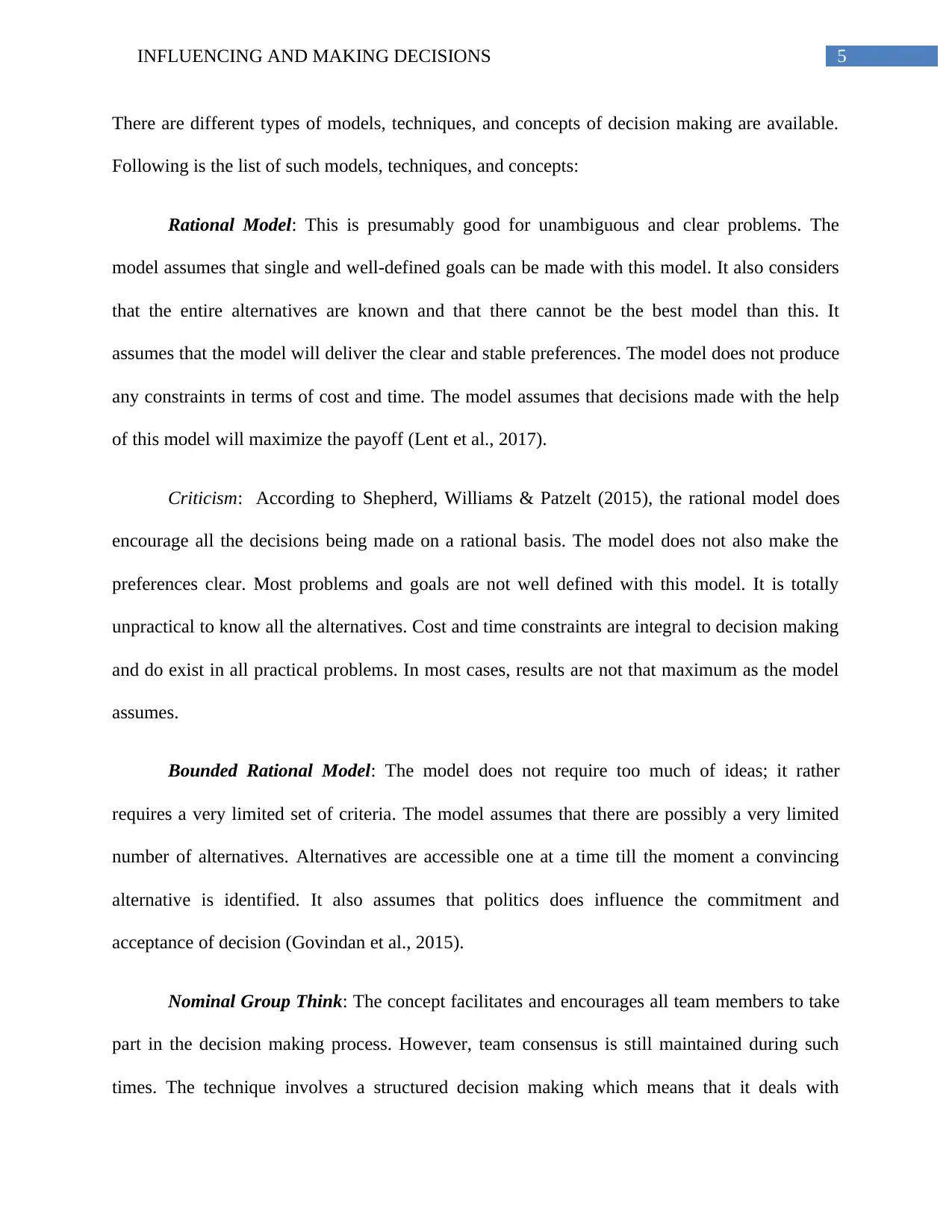
5INFLUENCING AND MAKING DECISIONS
There are different types of models, techniques, and concepts of decision making are available.
Following is the list of such models, techniques, and concepts:
Rational Model: This is presumably good for unambiguous and clear problems. The
model assumes that single and well-defined goals can be made with this model. It also considers
that the entire alternatives are known and that there cannot be the best model than this. It
assumes that the model will deliver the clear and stable preferences. The model does not produce
any constraints in terms of cost and time. The model assumes that decisions made with the help
of this model will maximize the payoff (Lent et al., 2017).
Criticism: According to Shepherd, Williams & Patzelt (2015), the rational model does
encourage all the decisions being made on a rational basis. The model does not also make the
preferences clear. Most problems and goals are not well defined with this model. It is totally
unpractical to know all the alternatives. Cost and time constraints are integral to decision making
and do exist in all practical problems. In most cases, results are not that maximum as the model
assumes.
Bounded Rational Model: The model does not require too much of ideas; it rather
requires a very limited set of criteria. The model assumes that there are possibly a very limited
number of alternatives. Alternatives are accessible one at a time till the moment a convincing
alternative is identified. It also assumes that politics does influence the commitment and
acceptance of decision (Govindan et al., 2015).
Nominal Group Think: The concept facilitates and encourages all team members to take
part in the decision making process. However, team consensus is still maintained during such
times. The technique involves a structured decision making which means that it deals with
There are different types of models, techniques, and concepts of decision making are available.
Following is the list of such models, techniques, and concepts:
Rational Model: This is presumably good for unambiguous and clear problems. The
model assumes that single and well-defined goals can be made with this model. It also considers
that the entire alternatives are known and that there cannot be the best model than this. It
assumes that the model will deliver the clear and stable preferences. The model does not produce
any constraints in terms of cost and time. The model assumes that decisions made with the help
of this model will maximize the payoff (Lent et al., 2017).
Criticism: According to Shepherd, Williams & Patzelt (2015), the rational model does
encourage all the decisions being made on a rational basis. The model does not also make the
preferences clear. Most problems and goals are not well defined with this model. It is totally
unpractical to know all the alternatives. Cost and time constraints are integral to decision making
and do exist in all practical problems. In most cases, results are not that maximum as the model
assumes.
Bounded Rational Model: The model does not require too much of ideas; it rather
requires a very limited set of criteria. The model assumes that there are possibly a very limited
number of alternatives. Alternatives are accessible one at a time till the moment a convincing
alternative is identified. It also assumes that politics does influence the commitment and
acceptance of decision (Govindan et al., 2015).
Nominal Group Think: The concept facilitates and encourages all team members to take
part in the decision making process. However, team consensus is still maintained during such
times. The technique involves a structured decision making which means that it deals with
⊘ This is a preview!⊘
Do you want full access?
Subscribe today to unlock all pages.

Trusted by 1+ million students worldwide
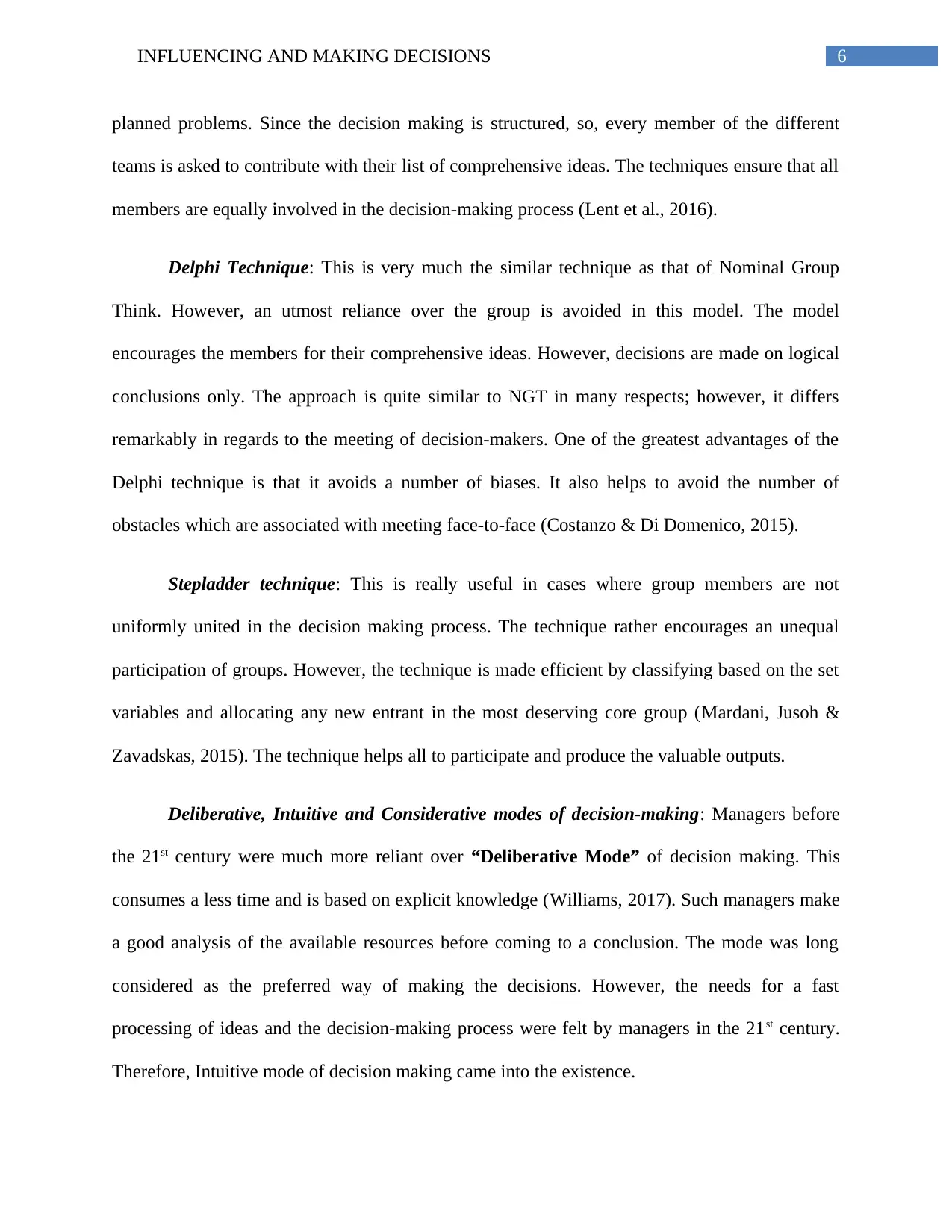
6INFLUENCING AND MAKING DECISIONS
planned problems. Since the decision making is structured, so, every member of the different
teams is asked to contribute with their list of comprehensive ideas. The techniques ensure that all
members are equally involved in the decision-making process (Lent et al., 2016).
Delphi Technique: This is very much the similar technique as that of Nominal Group
Think. However, an utmost reliance over the group is avoided in this model. The model
encourages the members for their comprehensive ideas. However, decisions are made on logical
conclusions only. The approach is quite similar to NGT in many respects; however, it differs
remarkably in regards to the meeting of decision-makers. One of the greatest advantages of the
Delphi technique is that it avoids a number of biases. It also helps to avoid the number of
obstacles which are associated with meeting face-to-face (Costanzo & Di Domenico, 2015).
Stepladder technique: This is really useful in cases where group members are not
uniformly united in the decision making process. The technique rather encourages an unequal
participation of groups. However, the technique is made efficient by classifying based on the set
variables and allocating any new entrant in the most deserving core group (Mardani, Jusoh &
Zavadskas, 2015). The technique helps all to participate and produce the valuable outputs.
Deliberative, Intuitive and Considerative modes of decision-making: Managers before
the 21st century were much more reliant over “Deliberative Mode” of decision making. This
consumes a less time and is based on explicit knowledge (Williams, 2017). Such managers make
a good analysis of the available resources before coming to a conclusion. The mode was long
considered as the preferred way of making the decisions. However, the needs for a fast
processing of ideas and the decision-making process were felt by managers in the 21st century.
Therefore, Intuitive mode of decision making came into the existence.
planned problems. Since the decision making is structured, so, every member of the different
teams is asked to contribute with their list of comprehensive ideas. The techniques ensure that all
members are equally involved in the decision-making process (Lent et al., 2016).
Delphi Technique: This is very much the similar technique as that of Nominal Group
Think. However, an utmost reliance over the group is avoided in this model. The model
encourages the members for their comprehensive ideas. However, decisions are made on logical
conclusions only. The approach is quite similar to NGT in many respects; however, it differs
remarkably in regards to the meeting of decision-makers. One of the greatest advantages of the
Delphi technique is that it avoids a number of biases. It also helps to avoid the number of
obstacles which are associated with meeting face-to-face (Costanzo & Di Domenico, 2015).
Stepladder technique: This is really useful in cases where group members are not
uniformly united in the decision making process. The technique rather encourages an unequal
participation of groups. However, the technique is made efficient by classifying based on the set
variables and allocating any new entrant in the most deserving core group (Mardani, Jusoh &
Zavadskas, 2015). The technique helps all to participate and produce the valuable outputs.
Deliberative, Intuitive and Considerative modes of decision-making: Managers before
the 21st century were much more reliant over “Deliberative Mode” of decision making. This
consumes a less time and is based on explicit knowledge (Williams, 2017). Such managers make
a good analysis of the available resources before coming to a conclusion. The mode was long
considered as the preferred way of making the decisions. However, the needs for a fast
processing of ideas and the decision-making process were felt by managers in the 21st century.
Therefore, Intuitive mode of decision making came into the existence.
Paraphrase This Document
Need a fresh take? Get an instant paraphrase of this document with our AI Paraphraser
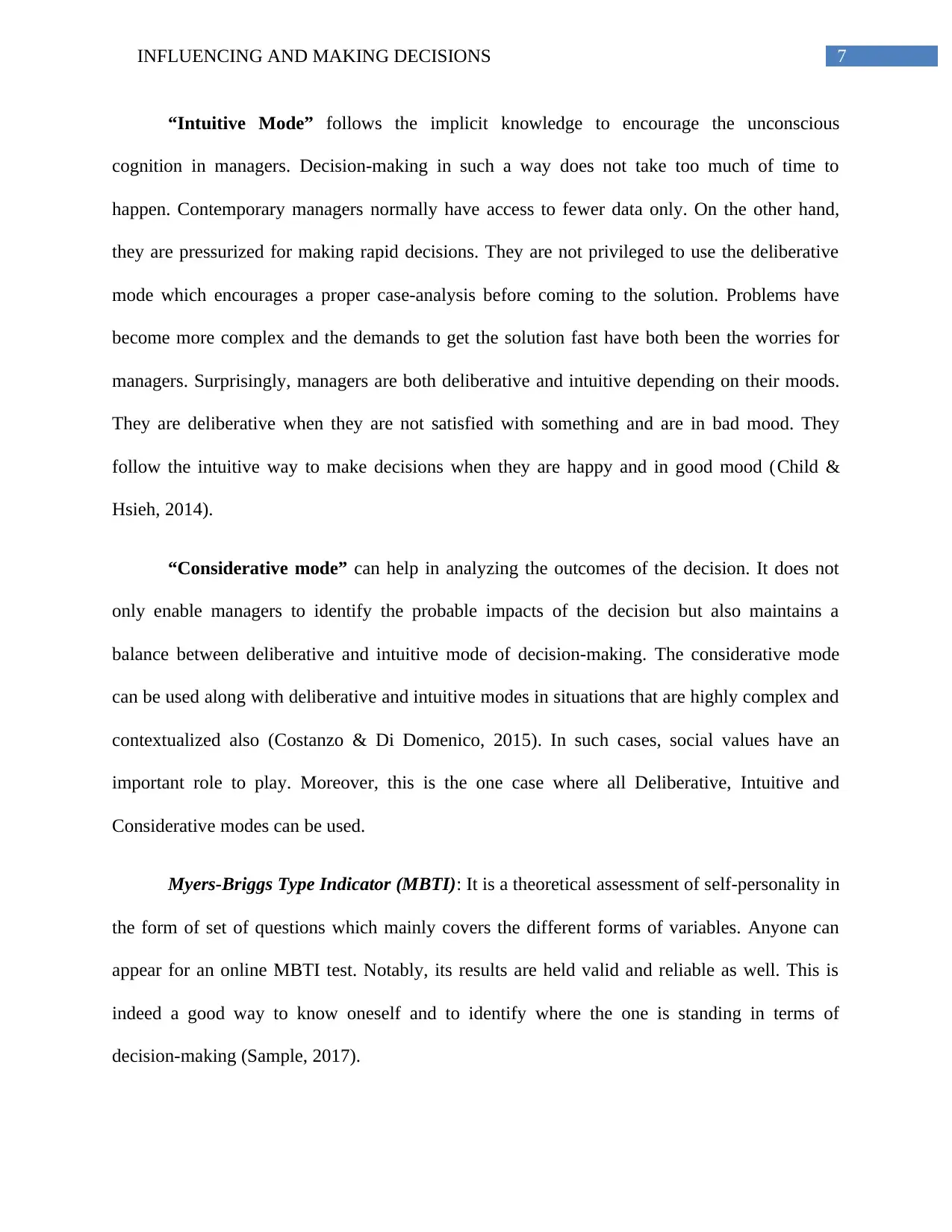
7INFLUENCING AND MAKING DECISIONS
“Intuitive Mode” follows the implicit knowledge to encourage the unconscious
cognition in managers. Decision-making in such a way does not take too much of time to
happen. Contemporary managers normally have access to fewer data only. On the other hand,
they are pressurized for making rapid decisions. They are not privileged to use the deliberative
mode which encourages a proper case-analysis before coming to the solution. Problems have
become more complex and the demands to get the solution fast have both been the worries for
managers. Surprisingly, managers are both deliberative and intuitive depending on their moods.
They are deliberative when they are not satisfied with something and are in bad mood. They
follow the intuitive way to make decisions when they are happy and in good mood (Child &
Hsieh, 2014).
“Considerative mode” can help in analyzing the outcomes of the decision. It does not
only enable managers to identify the probable impacts of the decision but also maintains a
balance between deliberative and intuitive mode of decision-making. The considerative mode
can be used along with deliberative and intuitive modes in situations that are highly complex and
contextualized also (Costanzo & Di Domenico, 2015). In such cases, social values have an
important role to play. Moreover, this is the one case where all Deliberative, Intuitive and
Considerative modes can be used.
Myers-Briggs Type Indicator (MBTI): It is a theoretical assessment of self-personality in
the form of set of questions which mainly covers the different forms of variables. Anyone can
appear for an online MBTI test. Notably, its results are held valid and reliable as well. This is
indeed a good way to know oneself and to identify where the one is standing in terms of
decision-making (Sample, 2017).
“Intuitive Mode” follows the implicit knowledge to encourage the unconscious
cognition in managers. Decision-making in such a way does not take too much of time to
happen. Contemporary managers normally have access to fewer data only. On the other hand,
they are pressurized for making rapid decisions. They are not privileged to use the deliberative
mode which encourages a proper case-analysis before coming to the solution. Problems have
become more complex and the demands to get the solution fast have both been the worries for
managers. Surprisingly, managers are both deliberative and intuitive depending on their moods.
They are deliberative when they are not satisfied with something and are in bad mood. They
follow the intuitive way to make decisions when they are happy and in good mood (Child &
Hsieh, 2014).
“Considerative mode” can help in analyzing the outcomes of the decision. It does not
only enable managers to identify the probable impacts of the decision but also maintains a
balance between deliberative and intuitive mode of decision-making. The considerative mode
can be used along with deliberative and intuitive modes in situations that are highly complex and
contextualized also (Costanzo & Di Domenico, 2015). In such cases, social values have an
important role to play. Moreover, this is the one case where all Deliberative, Intuitive and
Considerative modes can be used.
Myers-Briggs Type Indicator (MBTI): It is a theoretical assessment of self-personality in
the form of set of questions which mainly covers the different forms of variables. Anyone can
appear for an online MBTI test. Notably, its results are held valid and reliable as well. This is
indeed a good way to know oneself and to identify where the one is standing in terms of
decision-making (Sample, 2017).
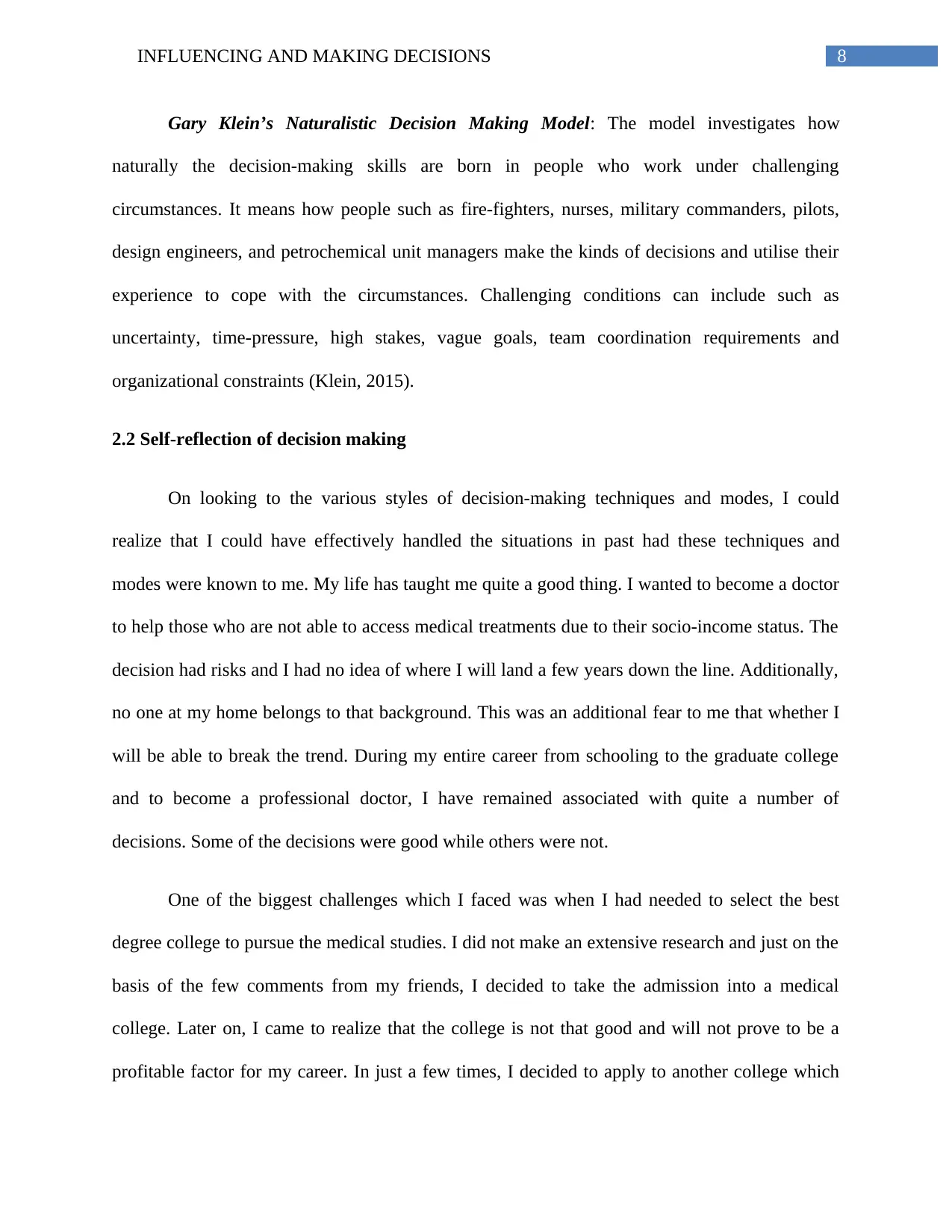
8INFLUENCING AND MAKING DECISIONS
Gary Klein’s Naturalistic Decision Making Model: The model investigates how
naturally the decision-making skills are born in people who work under challenging
circumstances. It means how people such as fire-fighters, nurses, military commanders, pilots,
design engineers, and petrochemical unit managers make the kinds of decisions and utilise their
experience to cope with the circumstances. Challenging conditions can include such as
uncertainty, time-pressure, high stakes, vague goals, team coordination requirements and
organizational constraints (Klein, 2015).
2.2 Self-reflection of decision making
On looking to the various styles of decision-making techniques and modes, I could
realize that I could have effectively handled the situations in past had these techniques and
modes were known to me. My life has taught me quite a good thing. I wanted to become a doctor
to help those who are not able to access medical treatments due to their socio-income status. The
decision had risks and I had no idea of where I will land a few years down the line. Additionally,
no one at my home belongs to that background. This was an additional fear to me that whether I
will be able to break the trend. During my entire career from schooling to the graduate college
and to become a professional doctor, I have remained associated with quite a number of
decisions. Some of the decisions were good while others were not.
One of the biggest challenges which I faced was when I had needed to select the best
degree college to pursue the medical studies. I did not make an extensive research and just on the
basis of the few comments from my friends, I decided to take the admission into a medical
college. Later on, I came to realize that the college is not that good and will not prove to be a
profitable factor for my career. In just a few times, I decided to apply to another college which
Gary Klein’s Naturalistic Decision Making Model: The model investigates how
naturally the decision-making skills are born in people who work under challenging
circumstances. It means how people such as fire-fighters, nurses, military commanders, pilots,
design engineers, and petrochemical unit managers make the kinds of decisions and utilise their
experience to cope with the circumstances. Challenging conditions can include such as
uncertainty, time-pressure, high stakes, vague goals, team coordination requirements and
organizational constraints (Klein, 2015).
2.2 Self-reflection of decision making
On looking to the various styles of decision-making techniques and modes, I could
realize that I could have effectively handled the situations in past had these techniques and
modes were known to me. My life has taught me quite a good thing. I wanted to become a doctor
to help those who are not able to access medical treatments due to their socio-income status. The
decision had risks and I had no idea of where I will land a few years down the line. Additionally,
no one at my home belongs to that background. This was an additional fear to me that whether I
will be able to break the trend. During my entire career from schooling to the graduate college
and to become a professional doctor, I have remained associated with quite a number of
decisions. Some of the decisions were good while others were not.
One of the biggest challenges which I faced was when I had needed to select the best
degree college to pursue the medical studies. I did not make an extensive research and just on the
basis of the few comments from my friends, I decided to take the admission into a medical
college. Later on, I came to realize that the college is not that good and will not prove to be a
profitable factor for my career. In just a few times, I decided to apply to another college which
⊘ This is a preview!⊘
Do you want full access?
Subscribe today to unlock all pages.

Trusted by 1+ million students worldwide
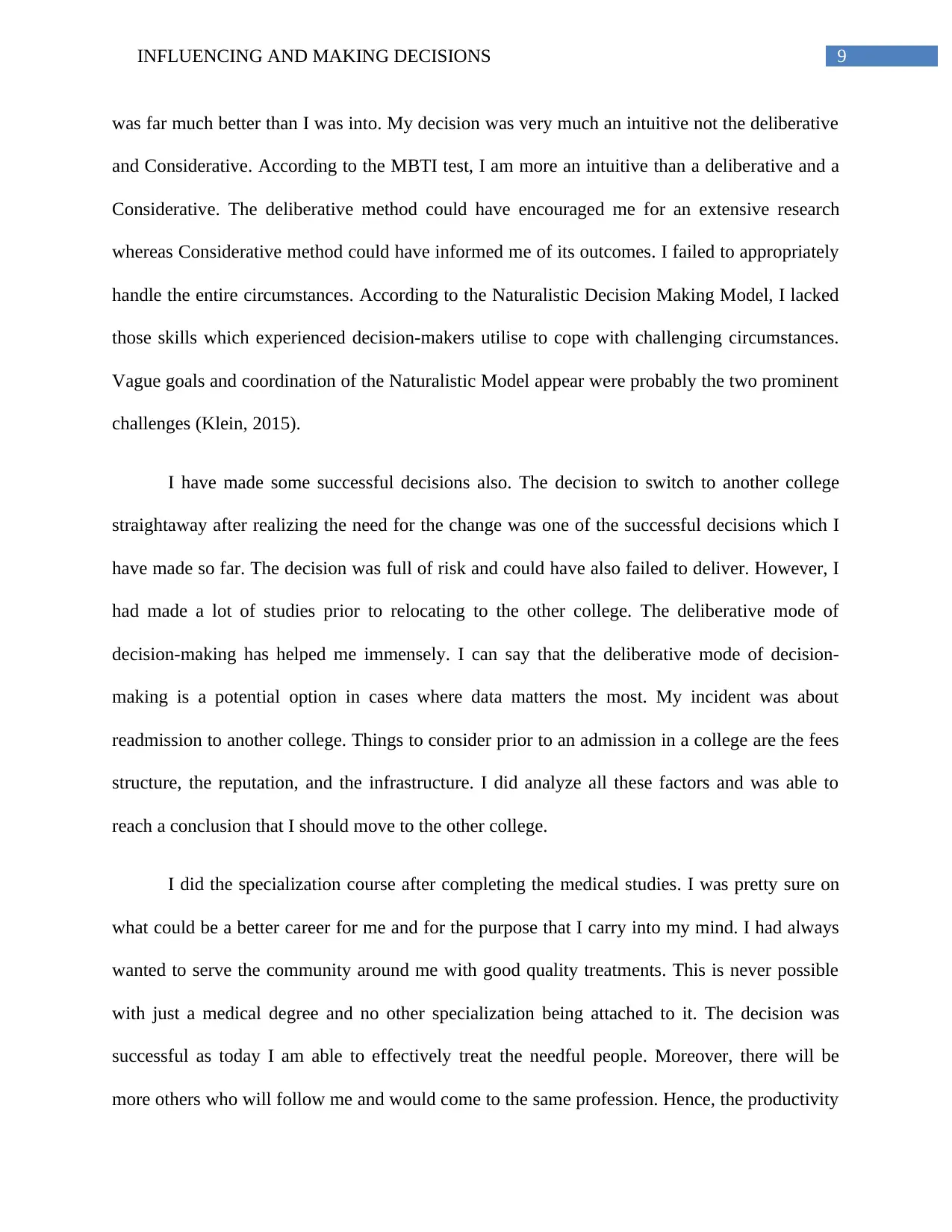
9INFLUENCING AND MAKING DECISIONS
was far much better than I was into. My decision was very much an intuitive not the deliberative
and Considerative. According to the MBTI test, I am more an intuitive than a deliberative and a
Considerative. The deliberative method could have encouraged me for an extensive research
whereas Considerative method could have informed me of its outcomes. I failed to appropriately
handle the entire circumstances. According to the Naturalistic Decision Making Model, I lacked
those skills which experienced decision-makers utilise to cope with challenging circumstances.
Vague goals and coordination of the Naturalistic Model appear were probably the two prominent
challenges (Klein, 2015).
I have made some successful decisions also. The decision to switch to another college
straightaway after realizing the need for the change was one of the successful decisions which I
have made so far. The decision was full of risk and could have also failed to deliver. However, I
had made a lot of studies prior to relocating to the other college. The deliberative mode of
decision-making has helped me immensely. I can say that the deliberative mode of decision-
making is a potential option in cases where data matters the most. My incident was about
readmission to another college. Things to consider prior to an admission in a college are the fees
structure, the reputation, and the infrastructure. I did analyze all these factors and was able to
reach a conclusion that I should move to the other college.
I did the specialization course after completing the medical studies. I was pretty sure on
what could be a better career for me and for the purpose that I carry into my mind. I had always
wanted to serve the community around me with good quality treatments. This is never possible
with just a medical degree and no other specialization being attached to it. The decision was
successful as today I am able to effectively treat the needful people. Moreover, there will be
more others who will follow me and would come to the same profession. Hence, the productivity
was far much better than I was into. My decision was very much an intuitive not the deliberative
and Considerative. According to the MBTI test, I am more an intuitive than a deliberative and a
Considerative. The deliberative method could have encouraged me for an extensive research
whereas Considerative method could have informed me of its outcomes. I failed to appropriately
handle the entire circumstances. According to the Naturalistic Decision Making Model, I lacked
those skills which experienced decision-makers utilise to cope with challenging circumstances.
Vague goals and coordination of the Naturalistic Model appear were probably the two prominent
challenges (Klein, 2015).
I have made some successful decisions also. The decision to switch to another college
straightaway after realizing the need for the change was one of the successful decisions which I
have made so far. The decision was full of risk and could have also failed to deliver. However, I
had made a lot of studies prior to relocating to the other college. The deliberative mode of
decision-making has helped me immensely. I can say that the deliberative mode of decision-
making is a potential option in cases where data matters the most. My incident was about
readmission to another college. Things to consider prior to an admission in a college are the fees
structure, the reputation, and the infrastructure. I did analyze all these factors and was able to
reach a conclusion that I should move to the other college.
I did the specialization course after completing the medical studies. I was pretty sure on
what could be a better career for me and for the purpose that I carry into my mind. I had always
wanted to serve the community around me with good quality treatments. This is never possible
with just a medical degree and no other specialization being attached to it. The decision was
successful as today I am able to effectively treat the needful people. Moreover, there will be
more others who will follow me and would come to the same profession. Hence, the productivity
Paraphrase This Document
Need a fresh take? Get an instant paraphrase of this document with our AI Paraphraser
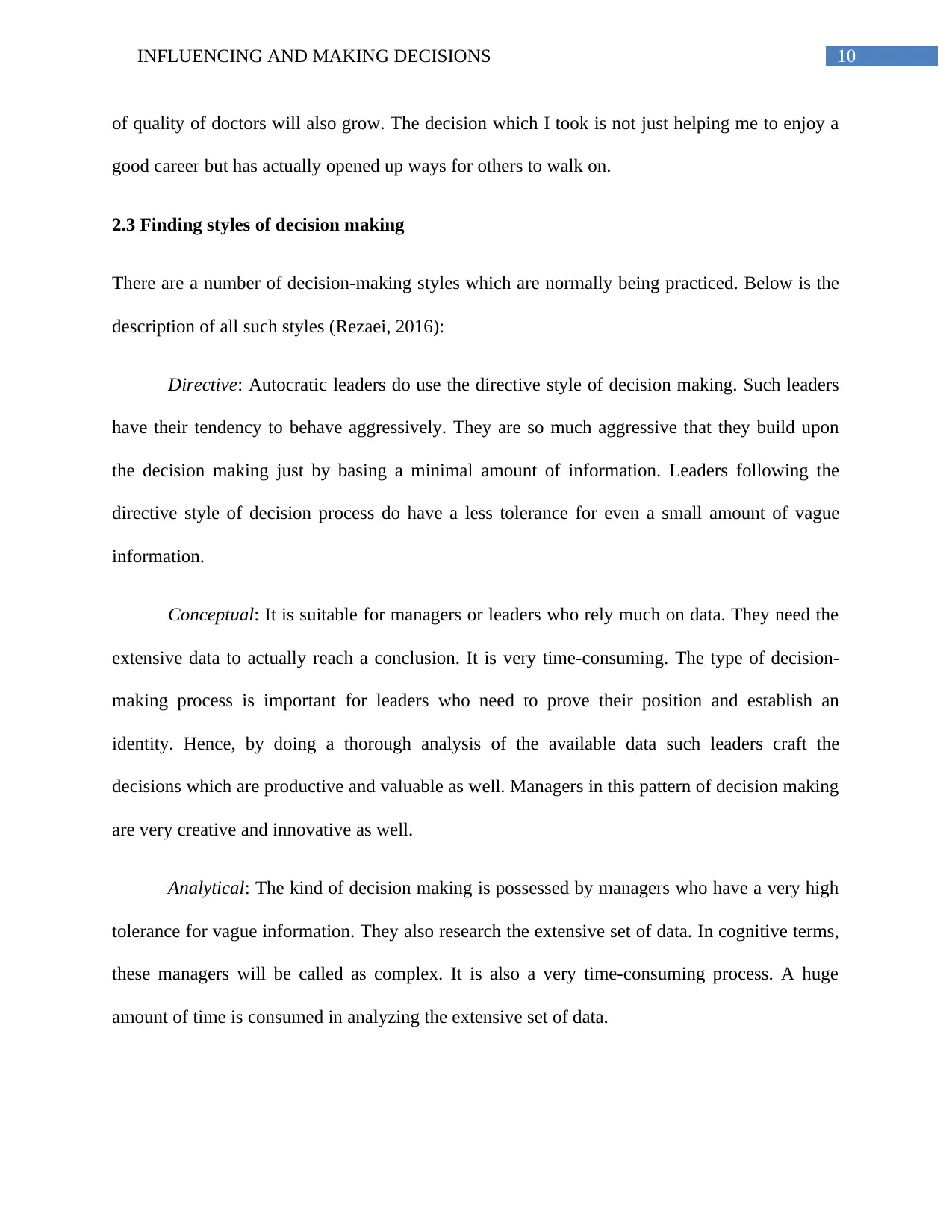
10INFLUENCING AND MAKING DECISIONS
of quality of doctors will also grow. The decision which I took is not just helping me to enjoy a
good career but has actually opened up ways for others to walk on.
2.3 Finding styles of decision making
There are a number of decision-making styles which are normally being practiced. Below is the
description of all such styles (Rezaei, 2016):
Directive: Autocratic leaders do use the directive style of decision making. Such leaders
have their tendency to behave aggressively. They are so much aggressive that they build upon
the decision making just by basing a minimal amount of information. Leaders following the
directive style of decision process do have a less tolerance for even a small amount of vague
information.
Conceptual: It is suitable for managers or leaders who rely much on data. They need the
extensive data to actually reach a conclusion. It is very time-consuming. The type of decision-
making process is important for leaders who need to prove their position and establish an
identity. Hence, by doing a thorough analysis of the available data such leaders craft the
decisions which are productive and valuable as well. Managers in this pattern of decision making
are very creative and innovative as well.
Analytical: The kind of decision making is possessed by managers who have a very high
tolerance for vague information. They also research the extensive set of data. In cognitive terms,
these managers will be called as complex. It is also a very time-consuming process. A huge
amount of time is consumed in analyzing the extensive set of data.
of quality of doctors will also grow. The decision which I took is not just helping me to enjoy a
good career but has actually opened up ways for others to walk on.
2.3 Finding styles of decision making
There are a number of decision-making styles which are normally being practiced. Below is the
description of all such styles (Rezaei, 2016):
Directive: Autocratic leaders do use the directive style of decision making. Such leaders
have their tendency to behave aggressively. They are so much aggressive that they build upon
the decision making just by basing a minimal amount of information. Leaders following the
directive style of decision process do have a less tolerance for even a small amount of vague
information.
Conceptual: It is suitable for managers or leaders who rely much on data. They need the
extensive data to actually reach a conclusion. It is very time-consuming. The type of decision-
making process is important for leaders who need to prove their position and establish an
identity. Hence, by doing a thorough analysis of the available data such leaders craft the
decisions which are productive and valuable as well. Managers in this pattern of decision making
are very creative and innovative as well.
Analytical: The kind of decision making is possessed by managers who have a very high
tolerance for vague information. They also research the extensive set of data. In cognitive terms,
these managers will be called as complex. It is also a very time-consuming process. A huge
amount of time is consumed in analyzing the extensive set of data.
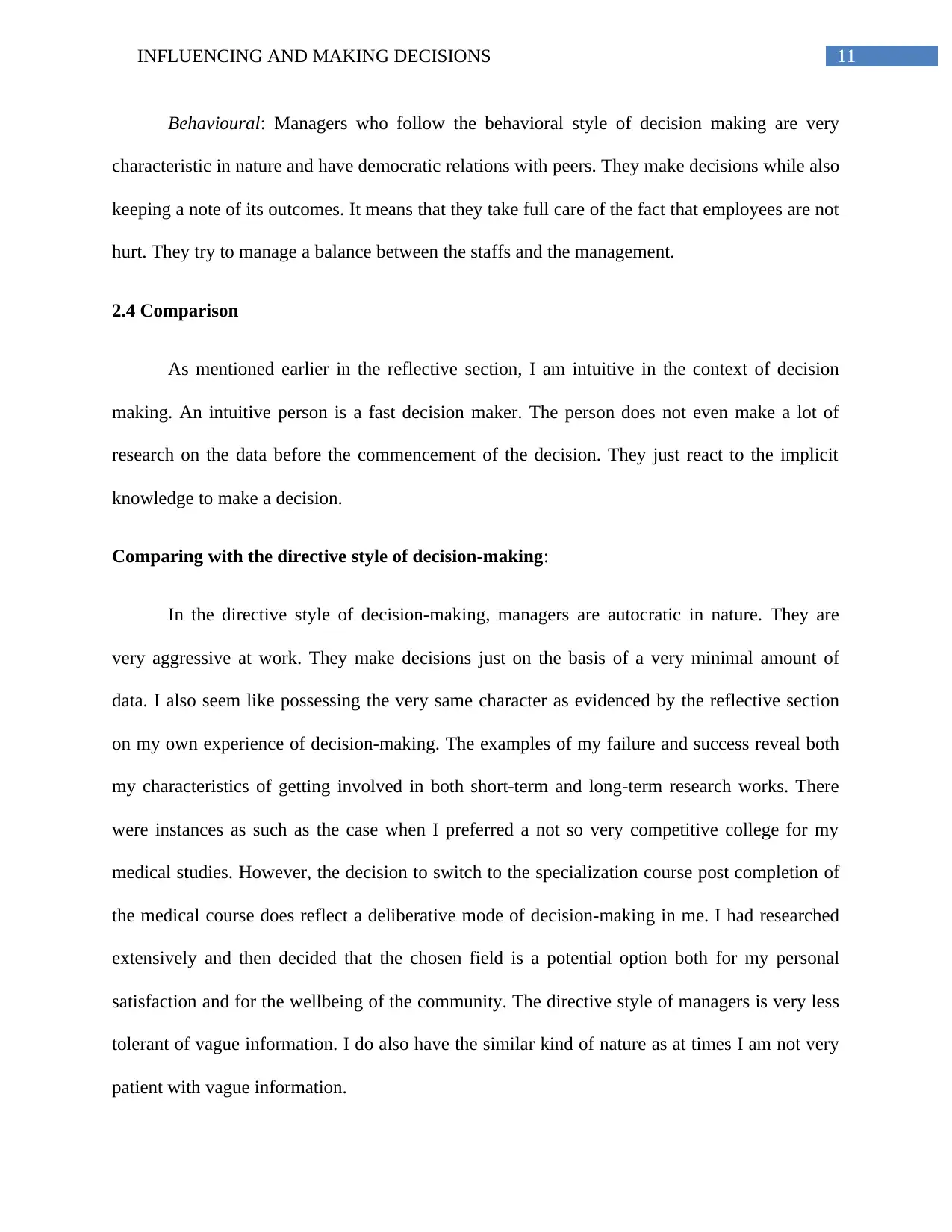
11INFLUENCING AND MAKING DECISIONS
Behavioural: Managers who follow the behavioral style of decision making are very
characteristic in nature and have democratic relations with peers. They make decisions while also
keeping a note of its outcomes. It means that they take full care of the fact that employees are not
hurt. They try to manage a balance between the staffs and the management.
2.4 Comparison
As mentioned earlier in the reflective section, I am intuitive in the context of decision
making. An intuitive person is a fast decision maker. The person does not even make a lot of
research on the data before the commencement of the decision. They just react to the implicit
knowledge to make a decision.
Comparing with the directive style of decision-making:
In the directive style of decision-making, managers are autocratic in nature. They are
very aggressive at work. They make decisions just on the basis of a very minimal amount of
data. I also seem like possessing the very same character as evidenced by the reflective section
on my own experience of decision-making. The examples of my failure and success reveal both
my characteristics of getting involved in both short-term and long-term research works. There
were instances as such as the case when I preferred a not so very competitive college for my
medical studies. However, the decision to switch to the specialization course post completion of
the medical course does reflect a deliberative mode of decision-making in me. I had researched
extensively and then decided that the chosen field is a potential option both for my personal
satisfaction and for the wellbeing of the community. The directive style of managers is very less
tolerant of vague information. I do also have the similar kind of nature as at times I am not very
patient with vague information.
Behavioural: Managers who follow the behavioral style of decision making are very
characteristic in nature and have democratic relations with peers. They make decisions while also
keeping a note of its outcomes. It means that they take full care of the fact that employees are not
hurt. They try to manage a balance between the staffs and the management.
2.4 Comparison
As mentioned earlier in the reflective section, I am intuitive in the context of decision
making. An intuitive person is a fast decision maker. The person does not even make a lot of
research on the data before the commencement of the decision. They just react to the implicit
knowledge to make a decision.
Comparing with the directive style of decision-making:
In the directive style of decision-making, managers are autocratic in nature. They are
very aggressive at work. They make decisions just on the basis of a very minimal amount of
data. I also seem like possessing the very same character as evidenced by the reflective section
on my own experience of decision-making. The examples of my failure and success reveal both
my characteristics of getting involved in both short-term and long-term research works. There
were instances as such as the case when I preferred a not so very competitive college for my
medical studies. However, the decision to switch to the specialization course post completion of
the medical course does reflect a deliberative mode of decision-making in me. I had researched
extensively and then decided that the chosen field is a potential option both for my personal
satisfaction and for the wellbeing of the community. The directive style of managers is very less
tolerant of vague information. I do also have the similar kind of nature as at times I am not very
patient with vague information.
⊘ This is a preview!⊘
Do you want full access?
Subscribe today to unlock all pages.

Trusted by 1+ million students worldwide
1 out of 20
Related Documents
Your All-in-One AI-Powered Toolkit for Academic Success.
+13062052269
info@desklib.com
Available 24*7 on WhatsApp / Email
![[object Object]](/_next/static/media/star-bottom.7253800d.svg)
Unlock your academic potential
Copyright © 2020–2025 A2Z Services. All Rights Reserved. Developed and managed by ZUCOL.





